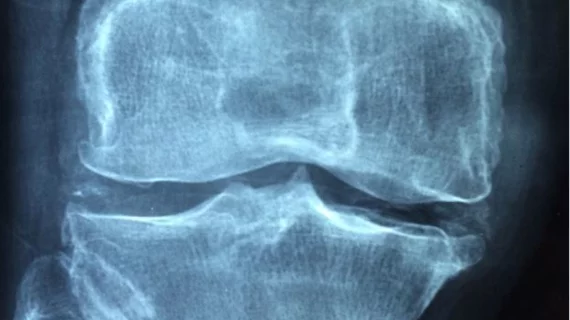Novel AI approach can help radiologists improve osteoarthritis x-ray diagnosis
A novel convolutional neural network (CNN) approach could be used to help radiologists improve their classification of osteoarthritis (OA) on knee radiographs, reported authors of a new study published in the Journal of Digital Imaging.
“The ultimate clinical outcome of osteoarthritis is often total joint replacement in the hip or knee, which is effective in managing symptoms and reversing loss of function in most patients, but is costly, not without risk of complications, and only effective for a limited length of time,” wrote Valentina Pedoia, with the Department of Radiology and Biomedical Imaging and Center for Digital Health Innovation in San Francisco, California, and colleagues.
Pedoia et al. developed a complex CNN that classified rates of no OA, mild, moderate and severe OA with nearly 84 percent, 70 percent, 70 percent and 86 percent specificity, respectively. The results may help improve care for OA patients.
In their study, researchers trained the CNN on nearly 26,000 individual bilateral PA fixed-flexion knee radiographs from the Osteoarthritis Initiative dataset across six various time points. An “ensemble” of neural networks used the Kellgren Lawrence (KL) grading system to classify OA using 5,941 testing and 7,779 validation images.
In addition to the reported sensitivity, the CNN achieved specificity rates for classifying no OA, mild, moderate and severe OA of 68 percent, 84 percent, 97.4 percent and 99 percent, respectively.
The team used saliency maps to confirm their CNN was selecting the appropriate features used in OA detection.
“Using state-of-the-art convolutional neural networks with novel implementations of their ensemble learning and inclusion of demographic variables directly into the network, we were able to produce a precise automatic classifier for the assessment of OA in knee radiographs,” Pedoia and colleagues wrote.
Finally, researchers conducted a single-blind experiment with an internal radiologist which showcased the interobserver reliability of KL classification. The radiologist agreed with nearly 30 percent of CNN cases. However, given the fact that only 54 total cases were sampled, the researchers were hesitant to tout the reported interobserver results.
Overall, Pedoia and colleagues believe the automatic classifier can help radiologists in an era of rapid imaging growth.
“These results suggest the use of our automatic classifier to assist radiologists in making more accurate and precise diagnosis with the increasing volume of radiographic image being taken in clinic,” the authors concluded.

